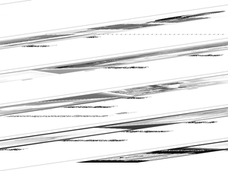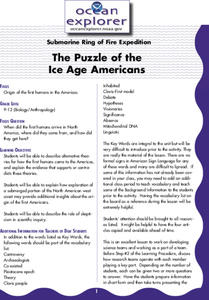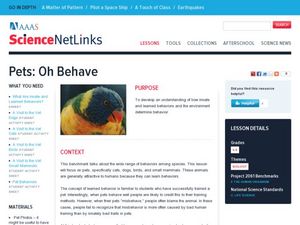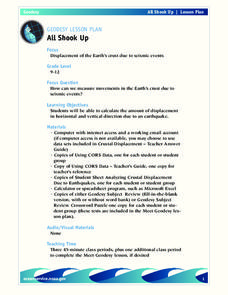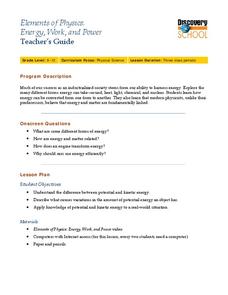Curated OER
Mixtures
Sixth graders experiment with mixtures. For this chemistry lesson, 6th graders determine which mixtures are considered heterogeneous, a suspension, a solution or a colloid. Students create a data sheet of what they discover.
Curated OER
Evolution: Natural Selection
Learners analyze and discuss the evolutionary history of dinosaurs. In this investigative lesson students monitor different organisms in the environment and analyze the pressures that affect the chances of survival.
Curated OER
Cypress/Tupelo Swamps
Young scholars study the geologic history of terrain, soils, and drainage patterns. They recognize ecological processes that determine the dynamic nature of habitats. They investigate the influence of human activity on the landscape.
Curated OER
Acid-Base Indicator Paper
Middle schoolers are able to prepare and use pH indicators in paper form. They find out the color of the indicator paper plus test solution may change with time. Students use red cabbage to use for the indicator.
Curated OER
Colorful Milk of Magnesia
Students explore acids, bases, and indicators. They observe the various colors of an acid-base indicator solution and the neutralization of an acidic solution by an antacid.
Curated OER
Discovering Owls
Students are introduced to different types of owls and owl pellets. They list several adaptations that benefit the owls. Students identify the various species of owl that live in Wisconsin. Students discuss owl pellets and identify the...
Curated OER
Earth & Beyond: Dryland Salinisation
In this earth and beyond worksheet, students read information about dryland salinsation, a serious problem facing Western Australia, and then answer 14 questions about the topic.
Curated OER
Why Study Air Pollution?
Eighth graders study air pollution and identify some causes, effects and solutions. In this air pollution lesson students complete several activities.
Curated OER
Lesson Plan
Learners play several activities that allow them to know the terminology used. In this project management lesson plan students create a storyboard.
Curated OER
99.86% - Measuring Our Sun's Mass
Students determine just how large the sun is. In this solar system lesson, students follow the prescribed steps to draw a box that represents the size of the sun and its mass compared to the entire solar system.
Curated OER
The Chemosynthetic Cafe
Students study photosynthesis and chemosynthesis. In this chemosynthetic lesson students explain the processes of these and define terms.
Curated OER
The Puzzle of the Ice Age Americans
Students describe alternative theories for how the first humans came to the Americas, and explain evidence that supports or contradicts these theories. They examine the role of skepticism in scientific inquiries.
Curated OER
Pets: Oh Behave
Students develop an understanding of how innate and learned behaviors and the environment determine behavior.
Curated OER
Summer: Getting the Bugs Out
Students study biodiversity while examining insects. They research insects that already exist and how they adapt to their environment.
Curated OER
Cytoplasmic Streaming
Students prepare successful wet mount slide of Elodea. They determine and identify environmental conditions that induce cytoplasmic streaming. They determine the positive aspects of cytoplasmic streaming. They illustrate knowledge and...
Curated OER
Topographic Map Unit Plan
Students examine topographic maps and discover how to decipher contour intervals, use contour lines and apply information to complete a topographic map lab. Working in groups, they identify the scale of the map, latitude and longitude,...
Curated OER
Microscopes
In this microscopes worksheet, 7th graders read information about microscopes and how they work. Students then complete several questions about the passage. Students study the diagram of a microscope using the letter definitions.
Curated OER
All Shook Up
Students measure movements in the Earth's crust due to seismic activity. Students calculate the amount of displacement in horizontal and vertical direction due to an earthquake.
Curated OER
Coral Mania
Students examine deep-sea coral. In this coral instructional activity, students identify the structure and function of a coral polyp. Students then create a model of a coral polyp.
Curated OER
Innovations in Obstetrics and Pediatrics
Learners study the history in obstetrics and pediatrics. In this investigative lesson students research and present information about winners of the Nobel Prize.
Curated OER
Atoms: The Building Block of Matter
Young scholars examine how scientific theories are developed. In this matter lesson, students explore the basic idea of quantum theory. They create a timeline of scientists, their contributions, and discoveries.
Curated OER
Elements In Chemistry: Solids, Liquids and Gases
Students investigate the kinetic-molecular theory. In this state of matter lesson, students consider the differences of melting glaciers, melting icebergs and investigate on what happens when submerged water melts.
Curated OER
The Periodic Table
Students examine the periodic table and how it was developed. In this chemistry lesson students identify common properties and uses of elements within a family.
Curated OER
Energy, Work and Power
Students examine the differences between potential and kinetic energy. For this physics lesson students view a video and apply what they learn about energy to apply it to real world situations.












